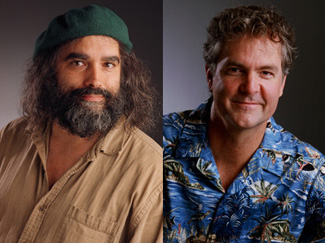The University of California, Santa Cruz, is among the leading institutions in a recent analysis of the hottest papers in molecular biology and genetics, standing at the top of the field by one measure used in the survey. Conducted by Thompson Scientific and published in the January/February edition of Science Watch, the survey looked at an elite selection of "high-impact" papers published between 2002 and 2006--those ranking among the top 1 percent in the field for the number of times they have been cited, or referred to, in other research papers.
UC Santa Cruz had the highest score of any institution for the number of citations per high-impact paper. When ranked by total number of citations, UCSC came in at number 26, just missing the list of the top 25 institutions, according to Science Watch editor Christopher King. The campus's top score for citations per paper resulted from the participation of UCSC researchers in a comparatively small number of highly cited reports as identified in the survey, King said.
In addition, two researchers at UCSC's Baskin School of Engineering--James Kent and David Haussler--were ranked fourth and ninth, respectively, on the list of authors with the most high-impact papers in this field.
UCSC's strong showing in this survey reflects the involvement of Haussler, Kent, and their colleagues at UCSC's Center for Biomolecular Science and Engineering (CBSE) in many of the most important recent papers in the field of molecular biology and genetics. These include the most-cited paper in the survey, a 2002 report in Nature on the mouse genome, which has now been cited more than 1,700 times. Of the more than 200 coauthors of the paper, 12 were affiliated with UCSC.
"I'm glad to see that the mouse genome paper is the most cited," said Kent, a CBSE associate research scientist. "I did personally put a lot of work into that paper."
Haussler, a professor of biomolecular engineering and director of the CBSE, said the sequencing of the mouse genome was important because it enabled a comparative analysis with the human genome. "It was the first time we were able to compare the genomes of two widely separated mammals. That was the beginning of our research on comparative genomics and led to a lot of exciting papers down the line," he said.
Haussler was a coauthor of 10 of the 13 high-impact papers from UCSC. Kent was a coauthor of 12 of those papers, including two on which he was the lead author. Although several of these high-impact papers were, like the mouse paper, large collaborative efforts with long lists of coauthors, other high-impact papers reported work done primarily at UCSC.
"Some of those are very much home-grown initiatives from our lab that we did the bulk of the research on," Haussler said. He also noted that the period covered in the survey just missed the 2001 publication of the human genome sequence, another highly cited paper that his group was involved in.
Haussler has been a pioneer in the field of bioinformatics, which brings the power of advanced computational techniques to bear on complex problems in molecular biology. He and Kent played a crucial role in the completion of the human genome sequence by an international consortium, and their group has since been involved in other major genome sequencing efforts. Kent, who earned his Ph.D. in molecular biology at UCSC, created the UCSC Genome Browser, a web-based tool used by biomedical researchers throughout the world.
"The Genome Browser and some of the other tools that Jim [Kent] has built are so widely used and have had such an impact, he is kind of a folk hero in this field for building these tools and making them available for other people to use," Haussler said. "Bioinformatics is having a huge impact on molecular biology and genetics; it's a major force in the field, and that really comes through in this survey."
The other trend Haussler noted in the list of UCSC's high-impact papers is the importance of comparative genomics. By comparing the genomes of different organisms using sophisticated computational analyses, Haussler's group has made important findings in several areas. These analyses have yielded clues about the evolutionary history of mammals and other vertebrates, and have also identified important regions in the human genome sequence that were previously unrecognized.
"We have discovered that many regions that had been called 'junk DNA' were actually conserved over long periods of evolution, suggesting that they are biologically important," Haussler said.
Several other UC campuses were highly ranked in the Science Watch survey: UC San Diego (fifth for total number of citations), UC Berkeley (seventh), and UC San Francisco (15th).
More information about several of the high-impact papers from UCSC can be found in earlier stories about the UCSC Genome Browser, mouse genome, rat genome, chimpanzee genome, ultra-conserved elements, and comparative genomics.



